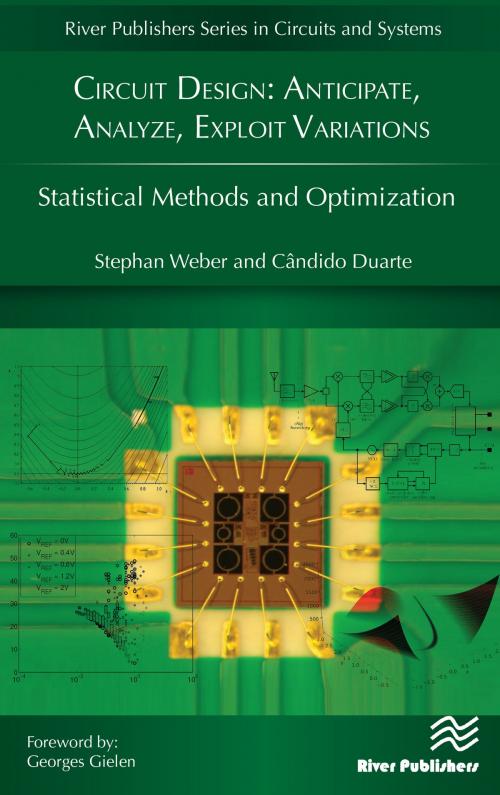Circuit Design - Anticipate, Analyze, Exploit Variations
Statistical Methods and Optimization
Nonfiction, Science & Nature, Technology, Electronics, Circuits| Author: | Stephan Weber, Candido Duarte | ISBN: | 9788793609921 |
| Publisher: | River Publishers | Publication: | March 31, 2017 |
| Imprint: | River Publishers | Language: | English |
| Author: | Stephan Weber, Candido Duarte |
| ISBN: | 9788793609921 |
| Publisher: | River Publishers |
| Publication: | March 31, 2017 |
| Imprint: | River Publishers |
| Language: | English |
Circuit Design = Science + Art! Designers need a skilled “gut feeling” about circuits and related analytical techniques, plus creativity, to solve all problems and to adhere to the specifications, the written and the unwritten ones. You must anticipate a large number of influences, like temperature effects, supply voltages changes, offset voltages, layout parasitics, and numerous kinds of technology variations to end up with a circuit that works. This is challenging for analog, custom-digital, mixed-signal or RF circuits, and often researching new design methods in relevant journals, conference proceedings and design tools gives the impression unfortunately that just a “wild bunch” of “advanced techniques” exist. On the other hand, state-of-the-art tools nowadays indeed offer a good cockpit to steer the design flow, which include clever statistical methods and optimization techniques.
Actually, this almost presents a second breakthrough, like the introduction of circuit simulators 40 years ago! Users can now conveniently analyze all the problems (discover, quantify, verify), and even exploit them, for example for optimization purposes.
Most designers are caught up on everyday problems, so we fit that “wild bunch” into a systematic approach for variation-aware design, a designer’s field guide and more. That is where this book can help! Circuit Design: Anticipate, Analyze, Exploit Variations starts with best-practise manual methods and links them tightly to up-to-date automation algorithms. We provide many tractable examples and explain key techniques you have to know. We then enable you to select and setup suitable methods for each design task – knowing their prerequisites, advantages and, as too often overlooked, their limitations as well.
The good thing with computers is that you yourself can often verify amazing things with little effort, and you can use software not only to your direct advantage in solving a specific problem, but also for becoming a better skilled, more experienced engineer. Unfortunately, EDA design environments are not good at all to learn about advanced numerics. So with this book we also provide two apps for learning about statistic and optimization directly with circuit-related examples, and in real-time so without the long simulation times. This helps to develop a healthy statistical gut feeling for circuit design.
The book is written for engineers, students in engineering and CAD / methodology experts. Readers should have some background in standard design techniques like entering a design in a schematic capture and simulating it, and also know about major technology aspects.
Circuit Design = Science + Art! Designers need a skilled “gut feeling” about circuits and related analytical techniques, plus creativity, to solve all problems and to adhere to the specifications, the written and the unwritten ones. You must anticipate a large number of influences, like temperature effects, supply voltages changes, offset voltages, layout parasitics, and numerous kinds of technology variations to end up with a circuit that works. This is challenging for analog, custom-digital, mixed-signal or RF circuits, and often researching new design methods in relevant journals, conference proceedings and design tools gives the impression unfortunately that just a “wild bunch” of “advanced techniques” exist. On the other hand, state-of-the-art tools nowadays indeed offer a good cockpit to steer the design flow, which include clever statistical methods and optimization techniques.
Actually, this almost presents a second breakthrough, like the introduction of circuit simulators 40 years ago! Users can now conveniently analyze all the problems (discover, quantify, verify), and even exploit them, for example for optimization purposes.
Most designers are caught up on everyday problems, so we fit that “wild bunch” into a systematic approach for variation-aware design, a designer’s field guide and more. That is where this book can help! Circuit Design: Anticipate, Analyze, Exploit Variations starts with best-practise manual methods and links them tightly to up-to-date automation algorithms. We provide many tractable examples and explain key techniques you have to know. We then enable you to select and setup suitable methods for each design task – knowing their prerequisites, advantages and, as too often overlooked, their limitations as well.
The good thing with computers is that you yourself can often verify amazing things with little effort, and you can use software not only to your direct advantage in solving a specific problem, but also for becoming a better skilled, more experienced engineer. Unfortunately, EDA design environments are not good at all to learn about advanced numerics. So with this book we also provide two apps for learning about statistic and optimization directly with circuit-related examples, and in real-time so without the long simulation times. This helps to develop a healthy statistical gut feeling for circuit design.
The book is written for engineers, students in engineering and CAD / methodology experts. Readers should have some background in standard design techniques like entering a design in a schematic capture and simulating it, and also know about major technology aspects.















